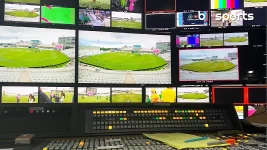Sports broadcasting is no longer just about cameras capturing live action. With the integration of real-time computer graphics, the viewer experience has evolved into a highly engaging, data-rich, and visually immersive event. From score overlays and player stats to virtual advertisements and 3D replays, computer graphics are redefining how fans interact with sports.
This digital transformation has turned passive viewing into a dynamic, interactive experience—bridging the gap between entertainment and analytics.
Real-time graphics refer to visuals generated and displayed live as the sports event is unfolding. These include:
These elements are powered by advanced graphics engines, sensor data, and AI algorithms to deliver visuals with minimal delay.
Engines like Vizrt, ChyronHego, and Unity are used to create broadcast-quality graphics instantly during live matches.
Cameras and player wearables provide data about player position, speed, and actions, feeding it into visual systems.
AR inserts computer-generated visuals into the real-world footage, such as:
Machine learning helps interpret gameplay in real time, generating intelligent insights and patterns for graphic representation.
Computer graphics help broadcasters:
Sports teams also use real-time graphics off-camera:
What viewers see as visual entertainment is often part of a broader performance analysis system.
Do you think graphics have improved your experience of watching sports?
Which sport uses the best visual technology, in your opinion?
What new kind of real-time graphic would you like to see during a live match?
Drop your views in the comments below!
This digital transformation has turned passive viewing into a dynamic, interactive experience—bridging the gap between entertainment and analytics.
What Are Real-Time Graphics in Sports?
Real-time graphics refer to visuals generated and displayed live as the sports event is unfolding. These include:
- On-screen scores and timers
- Heat maps showing player movement
- Animated tactical breakdowns
- Augmented reality visuals like line markers in cricket or first-down lines in American football
- Virtual replays that recreate moments from multiple angles
These elements are powered by advanced graphics engines, sensor data, and AI algorithms to deliver visuals with minimal delay.
Key Technologies Behind the Graphics
1.
Engines like Vizrt, ChyronHego, and Unity are used to create broadcast-quality graphics instantly during live matches.
2.
Cameras and player wearables provide data about player position, speed, and actions, feeding it into visual systems.
3.
AR inserts computer-generated visuals into the real-world footage, such as:
- Ball trajectory in cricket or tennis
- Shot clocks and stat panels in basketball
- Virtual sponsor logos on the field
4.
Machine learning helps interpret gameplay in real time, generating intelligent insights and patterns for graphic representation.
Applications in Popular Sports
 Football (Soccer)
Football (Soccer)
- Tactical replays with formation overlays
- Live player statistics and running distance
- Virtual offside lines using AR
 Cricket
Cricket
- Ball tracking (Hawk-Eye)
- 3D pitch maps and wagon wheels
- Ultra-edge and Snickometer visualizations
 Basketball
Basketball
- Shot charts and player heat maps
- Jump height and sprint speed data
- Virtual player comparisons in replays
 American Football
American Football
- Yellow first-down marker
- Real-time player substitution updates
- Instant replay animations of touchdowns
Enhancing Viewer Engagement
Computer graphics help broadcasters:
- Keep audiences informed with live metrics
- Make gameplay understandable with explainer visuals
- Engage casual fans who might not grasp technical rules
- Promote sponsors via virtual advertising on scoreboards, fields, and jerseys
- Create fan polls, AR experiences, and social media integrations for deeper interaction
Advantages for Coaches and Analysts
Sports teams also use real-time graphics off-camera:
- Analyzing player performance
- Planning strategies with heat maps
- Reviewing match footage with 3D breakdowns
- Injury prevention through visual load analysis
What viewers see as visual entertainment is often part of a broader performance analysis system.
Challenges and Future Trends
- Latency Issues: Rendering must occur with almost zero delay.
- Data Accuracy: Sensors must provide real-time, reliable input.
- Overload Risk: Too many graphics can overwhelm viewers.
- Next-Gen Development:
- 360-degree immersive replays
- Holographic sports viewing
- AI-generated commentary overlays
- Interactive broadcasts through VR platforms
Join the Conversation
Do you think graphics have improved your experience of watching sports?
Which sport uses the best visual technology, in your opinion?
What new kind of real-time graphic would you like to see during a live match?
Drop your views in the comments below!

